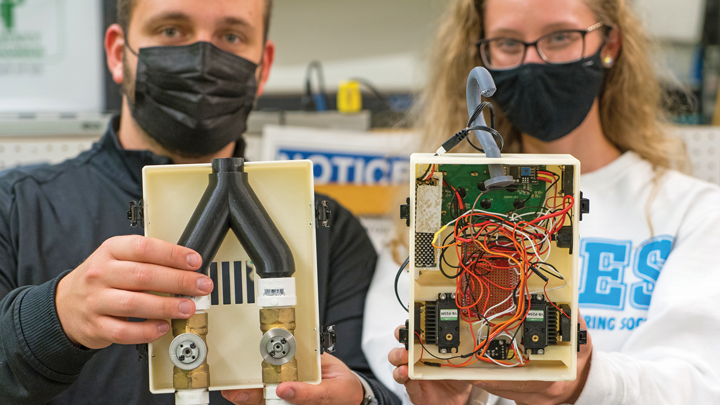University
Students Create Lifesaving Medical Innovation to Help End Worldwide Ventilator Shortage

By Aaron Hilf | USF News
BIOMEDICAL ENGINEERING GRADUATES from USF are receiving national accolades for a prototype device that may help solve the critical shortage of lifesaving ventilators seen around the world throughout the COVID-19 pandemic.
The Eucovent, a patent-pending device that allows two patients to be ventilated by a single machine, was developed by three students who have since graduated: Carolyna Yamamoto Alves Pinto, Abby Blocker and Jacob Yarinsky. The trio built the device as part of their biomedical engineering degree senior design project.
“I think what stood out most was how relevant a topic ventilation was at the time, and still is today,” Yarinsky says. “Especially with what you saw happening around the world with COVID-19 and hospitals not having enough ventilators for the numbers of patients they were treating. The project seemed extremely relevant and meaningful.”
That idea was submitted to the class by Moffitt Cancer Center researchers Aaron Muncey, Heiko Enderling and Stefano Passeto, who were looking for novel solutions to problems with co-ventilation. While there are existing devices capable of “splitting” airflow to multiple patients, most available solutions do not offer any type of customization. This is particularly problematic as patients require different volumes of airflow depending on their lung compliance and body weight, among other factors. For example, a 150-pound woman might require substantially less airflow than a 250-pound man.
To solve this, the team employed two primary techniques: dynamic resistance and time multiplexing. Dynamic resistance refers to an obstruction that restricts the amount of air delivered to each patient. To accomplish this, the group fabricated custom valves that can be independently adjusted to meet each patient’s individual airflow needs. By using time multiplexing, a common digital signals technique suggested to the team by USF Professor Christopher Passaglia, the device can alternate between patients, efficiently delivering breaths to each person independently.
Along with these two primary solutions, the team members had to utilize all of their undergraduate research experience for the project. Using their knowledge of biomechanics, along with such methods as 3D printing, computer programming and modeling, as well as computer-aided design, the group was able to complete and test the prototype with much success.
The relevance of such a device became clear during the COVID-19 pandemic, as hospitals around the world struggled to provide ventilators to every patient who needed one. The Eucovent effectively doubles a hospital’s existing capacity without having to purchase additional costly ventilators. The team says its use reaches far beyond the current pandemic, with applications in natural disaster settings, remote locations and low-resource areas.
“We believe the Eucovent provides many benefits, including cost and safety,” Alves Pinto says. “Compared to a new ventilator, the device is extremely low-cost, making ventilation more accessible and affordable. It also offers a higher level of patient care compared to existing solutions, making it a safer and more reliable option for co-ventilation.”
“This project shows the opportunity that we have for joint research endeavors between Moffitt Cancer Center and USF,” says Enderling, a researcher in Moffitt’s Integrated Mathematical Oncology unit. “It was truly humbling and inspiring to see how the students took the initial ideas and completely transformed, designed and implemented this highly innovative device. We sincerely hope that these results lay the foundation for a clinical device that can help a lot of patients in different scenarios around the world.”
The high praise received for the device inspired the team to pursue local and national innovation competitions. They first entered the Jabil Innovation Technology Challenge, a statewide competition for Florida undergraduate, graduate and doctoral students. After winning the $10,000 first prize, the students set their sights on the National Institute of Biomedical Imaging and Bioengineering’s annual Design by Biomedical Undergraduate Teams Challenge, supported by the National Institutes of Health and VentureWell. This prestigious competition is open to teams from across the country and had previously been won by groups from universities such as Stanford and Columbia. This year, the USF team and their Eucovent took the $20,000 first prize.
“It’s incredibly gratifying to be acknowledged at this level, especially for something that we believe could one day save lives,” Blocker says. “We learned so much through this capstone experience and it really gave us the opportunity to use all of the knowledge and skills we’d gathered during our undergrad.”
The group credits their undergraduate experience in USF’s Department of Medical Engineering for giving them the tools to create such an innovative and impactful device. All three graduated summa cum laude from the department with degrees in biomedical engineering. Since graduating, Alves Pinto has begun a doctoral program at Johns Hopkins University. Blocker is preparing to begin a master’s in biomedical engineering at the University of Cape Town in South Africa and Yarinsky is working as an engineer at Nilogen Oncosystems in Tampa.
The Department of Medical Engineering is a joint program between the USF College of Engineering and USF Health Morsani College of Medicine. It was first created through funding from the State of Florida’s preeminence program. In 2018, the Florida Board of Governors designated USF as a Preeminent State Research University, allocating more than $6 million in new funding to enhance research and student success activities in strategic areas. USF is one of very few universities to have a medical engineering department and just one of four in Florida to offer a Bachelor of Science degree in biomedical engineering.